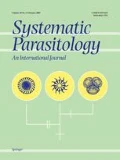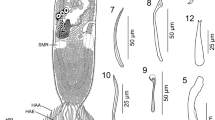Abstract
Nematode specimens of three species, Terranova scoliodontis (Baylis, 1931) (Ascaridida, Anisakidae), Echinocephalus sinensis Ko, 1975 and E. overstreeti Deardorff & Ko, 1983 (both Spirurida, Gnathostomatidae) were collected from the tiger shark Galeocerdo cuvier, the ray Aetobatus cf. narinari and the blotched fantail ray Taeniura meyeni, respectively, from the coastal waters of New Caledonia, South Pacific. Their examination, including scanning electron microscopy (SEM), made it possible to obtain some new data on their morphology, e.g. in relation to the number and arrangement of male caudal papillae in T. scoliodontis and both Echinocephalus spp., the presence of ventral cuticular ornamentations in T. scoliodontis and the number of transverse spines on the cephalic bulb in Echinocephalus spp. All these species are reported for the first time from New Caledonian waters and G. cuvier is a new host species for T. scoliodontis. SEM examination of the fourth-stage larvae of E. overstreeti from the type-host showed the presence of anterior dorsal and ventral groups of minute spines on the cephalic bulb to be an important taxonomic feature for␣the interspecific distinction of Echinocephalus larvae and questions previous data on the occurrence of E. overstreeti larvae in many elasmobranch fishes and molluscs in Australian waters.
Résumé
Des Nématodes appartenant à trois espèces, Terranova scoliodontis (Baylis, 1931) (Ascaridida, Anisakidae), Echinocephalus sinensis Ko, 1975 et E. overstreeti Deardorff & Ko, 1983 (tous deux Spirurida, Gnathostomatidae) ont été collectés respectivement du requin tigre Galeocerdo cuvier et des raies Aetobatus cf. narinari et Taeniura meyeni, des eaux côtières de Nouvelle-Calédonie, Pacifique Sud. Leur étude, en particulier en microscopie électronique à balayage (MEB) a permis d’obtenir de nouvelles informations sur leur morphologie, par exemple sur le nombre et la disposition des papilles caudales mâles chez T. scoliodontis et␣les deux espèces d’Echinocephalus, la présence d’ornementations cuticulaires ventrales chez T. scoliodontis, et le nombre d’épines transversales sur le bulbe céphalique des Echinocephalus. Toutes ces espèces sont mentionnées pour la première fois des eaux de Nouvelle-Calédonie et G. cuvier est un nouvel hôte pour T.␣scoliodontis. L’examen au MEB de la larve de quatrième stade d’E. overstreeti, provenant de l’hôte-type, a montré que les groupes antérieurs et postérieurs de petites épines sur le bulbe céphalique sont un caractère taxonomique important pour la distinction interspécifique des larves d’Echinocephalus et met en doute des informations antérieures sur la présence de larves d’E. overstreeti chez de nombreux Élasmobranches et Mollusques des eaux d’Australie.
Similar content being viewed by others
References
Andrews R.H., Beveridge I., Adams M., Baverstock P.R. (1988) Identification of life cycle stages of the nematode Echinocephalus overstreeti by allozyme electrophoresis. Journal of Helminthology 62: 153–157
Baylis H.A. (1931) Some Ascaridae from Queensland. Annals and Magazine of Natural History Series 10 8: 95–102
Beveridge, I. (1985) A redescription of Echinocephalus uncinatus Molin, 1858 (Nematoda, Gnathostomatoidea) from European rays, Dasyatis pastinaca (Linnaeus, 1758). Bulletin du Muséum National d’Histoire Naturelle, Paris, sér. 4, section A, 7, 781–790
Beveridge, I. (1987) Echinocephalus overstreeti Deardorff & Ko, 1983 (Nematoda: Gnathostomatoidea) from elasmobranchs and molluscs in South Australia. Transactions of the Royal Society of South Australia, 111, 79–92
Beveridge, I. (1991) The distribution of Echinocephalus overstreeti Deardorff & Ko (Nematoda), a parasite of elasmobranch fishes in Australian waters. Transactions of the Royal Society of South Australia, 115, 107
Brooks D.R., Deardorff T.L. (1988) Rhinebothrium devaneyi n. sp. (Eucestoda: Tetraphyllidea) and Echinocephalus overstreeti Deardorff and Ko, 1983 (Nematoda: Gnathostomatidae) in a thorny back ray, Urogymnus asperrimus, from Enewetak Atoll, with phylogenetic analysis of both species groups. Journal of Parasitology 74: 459–465
Bruce N.L., Cannon L.R.G. (1990) Ascaridoid nematodes from sharks from Australia and the Solomon Islands, southwestern Pacific Ocean. Invertebrate Taxonomy 4: 763–783
Deardorff T.L. (1987) Redescription of Pulchrascaris chiloscyllii (Johnston & Mawson, 1951) (Nematoda: Anisakidae), with comments on species in Pulchrascaris and Terranova. Proceedings of the Helminthological Society of Washington 54: 28–39
Deardorff T.L., Ko R.C. (1983) Echinocephalus overstreeti sp. n. (Nematoda: Gnathostomatidae) in the stingray, Taeniura melanopilos Bleeker, from the Marquesas Islands, with comments on E. sinensis Ko, 1975. Proceedings of the Helminthological Society of Washington 50: 285–293
Froese, R. & Pauly, D. (Eds) (2005) FishBase. World Wide Web electronic publication. http://www.fishbase.org, version 06/2005
Gibson D.I., Colin J.A. (1982) The Terranova enigma. Parasitology 85(2): xxxvi–xxxvii
Hoberg E.P., Brooks D.R., Molina-Ureña H., Erbe E. (1998) Echinocephalus janzeni n. sp. (Nematoda: Gnathostomatidae) in Himantura pacifica (Chondrichthyes: Myliobatiformes) from the Pacific coast of Costa Rica and Mexico, with historical biogeographic analysis of the genus. Journal of Parasitology 84: 571–581
Ko R.C. (1975) Echinocephalus sinensis n. sp. (Nematoda: Gnathostomatidae) from the ray (Aetabatus flagellum) in Hong Kong, Southern China. Canadian Journal of Zoology 53: 490–500
Ko R.C., Ling J., Adal M.N. (1980) Cephalic anatomy of a gnathostomatid nematode Echinocephalus sinensis, parasite of oysters and rays. Journal of Morphology 165: 301–317
Marie A.D., Justine J.-L. (2005) Monocotylids (Monogenea: Monopisthocotylea) from Aetobatus cf. narinari off New Caledonia, with a description of Decacotyle elpora n. sp. Systematic Parasitology 60: 175–185
Millemann R.E. (1951) Echinocephalus pseudouncinatus n. sp., a nematode parasite of the abalone. Journal of Parasitology 37: 435–439
Mozgovoy, A.A. (1953) [Ascaridata of animals and man and the diseases caused by them.] Moscow: Publishing House of the USSR Academy of Sciences. Osnovy Nematodologii, 2, 616 pp. (In Russian)
Obiekezie A.I., Ander K., Lick R., Möller H., Palm H. (1992) External lesions and flesh parasites in commercial fishes of Nigerian inshore waters. Aquatic Living Resources 5: 173–183
Whittington I.D. (1998) Diversity “down under”: monogeneans in the Antipodes (Australia) with a prediction of monogenean biodiversity worldwide. International Journal for Parasitology 28:1481–1493
Acknowledgements
Amandine Marie is thanked for her enthusiasm and skill in organising the team needed for the capture of a large tiger shark. Other students involved in fishing operations and the collection of parasites were Eric Bureau, Maya Robert, Chloé Journo, Nathaniel Cornuet, Isabelle Jollit, Sylvain Richer de Forges and Violette Justine; Marc Negrello, on board the R/V ‘Enzo’; and Nicole Fabre, Laurent Pascal and Augustin ‘Jean-Pierre’ Agourere are thanked for their help in shark fishing. Prof. Claude Chauvet (UNC, Université de Nouvelle-Calédonie, Nouméa, New Caledonia) and Jean-Louis Pagnon are gratefully thanked for collecting fish on board the R/V ‘Alcyon’. Soazig Le Mouellic (UNC) and Angelo di Matteo (IRD) provided technical help. Prof. Louis Euzet (Sète, France) provided help and advice during the parasite collection and preparation. Peter Last (CSIRO, Australia) gave advice on the identification of the spotted eagle ray. Thanks are also due to the staff of the Laboratory of Electron Microscopy of the Institute of Parasitology, ASCR, at České Budějovice for their technical assistance and Irena Husáková from the Department of Helminthology of the same Institute for her help with the preparation of the illustrations. The authors are very grateful to Dr David Gibson, Natural History Museum, London for revising the English and his help with the literature. This study was partly supported by grant no. 524/06/0170 from the Grant Agency of the Czech Republic and by the research project (Z60220518) of the Institute of Parasitology, Academy of Sciences of the Czech Republic.
Author information
Authors and Affiliations
Corresponding author
Rights and permissions
About this article
Cite this article
Moravec, F., Justine, JL. Three nematode species from elasmobranchs off New Caledonia. Syst Parasitol 64, 131–145 (2006). https://doi.org/10.1007/s11230-006-9034-x
Accepted:
Published:
Issue Date:
DOI: https://doi.org/10.1007/s11230-006-9034-x




